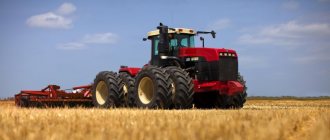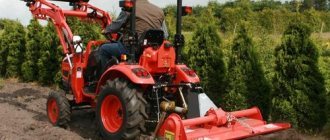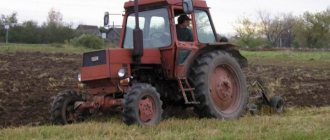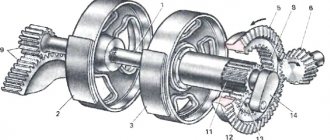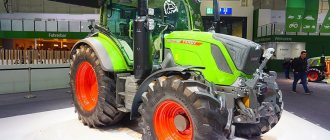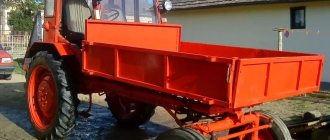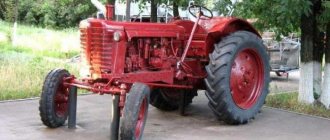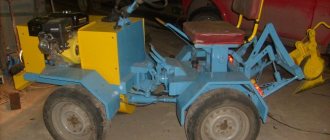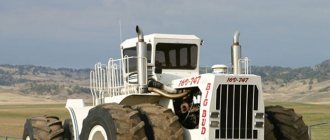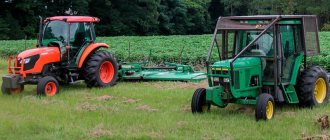USSR tractors were the first machines, the production of which was given great importance. Special equipment was supplied to collective farms, whose task was to implement the food program. The first tractors provided high labor productivity when performing agricultural work. Despite their low power, they coped well with the assigned tasks. Tractor drivers in the union were revered people, considered literate and educated.
K-700/701 "Kirovets"
0
See all photos in the gallery
The first tractor left the assembly shop and entered the fields of the country on July 13, 1962. Mass production began in 1969. It consists of front and rear semi-frames connected by vertical (to ensure the tractor turns) and horizontal (to ensure contact with the soil of all four wheels) hinges. With an engine power of 220 hp. with., making it possible to use wide-cut implements, the K-700 increased the productivity of agricultural work by 2.5-3 times compared to other tractors. The K-700 was developed as a dual-use product: in wartime it was supposed to be used as an artillery tractor. Many years of experience in operating the machine in various conditions and climatic zones have shown high reliability, simplicity and ease of maintenance, maintainability and long service life. On February 1, 2002, the St. Petersburg Tractor Plant ceased production of the Kirovets K-700A and K-701 tractors with the note that they were morally obsolete.
2.
Why did tracked tractors prevail in the USSR, but not now?
In the 60s/70s of the twentieth century, the leading experts of the Soviet Union in the field of agriculture, after many years of detailed research, came to the conclusion that tracked tractors are much more efficient and economical to operate than wheeled tractors of similar power.
With all the shortcomings of the tracked base (in any business there are pros and cons), the following was noted. When measuring soil density along the tracks of caterpillars, no significant compaction of the fertile layer was noted. While in the tracks of the wheels (especially powerful tractors such as the T-150 or K-700), the hardness of the soil increased significantly. Especially at a depth of 12-15 cm. Experiments have demonstrated that such soil compaction in the tracks of tractors subsequently reduces yields by up to 25%. These are quite significant figures, which become even more significant if we convert the percentages into centners of grain.
Another advantage of tracked tractors was determined to be that their “slip” parameters are many times lower. The wheel slips much more than the caterpillar, abrading valuable fertile soil into dust, which is then carried by the wind.
At the same time, the tracked base provides better traction and higher maneuverability. This makes it possible to enter the fields earlier and the ability to work on significantly moist soils. And early closure of moisture has always been considered conducive to obtaining a good harvest, especially under our climatic conditions, as well as under tight agrotechnical deadlines.
All this, as well as the fact that tracked tractors have higher traction characteristics than wheeled ones when using engines of the same power, led to the fact that the largest tractor factories - Volgograd, Kharkov, Altai - were focused on the production of tracked tractors. And up to 90% of tractors produced in the USSR were tracked. The absolute leader is the DT-75, of which more than three million were made.
Now the situation has changed dramatically: 87% of operating tractors in Russia are wheeled, and only 13% are tracked (and their number is becoming even smaller from year to year). There are several reasons for this. The three powerful factories mentioned above are ruined and, literally, lie in ruins. Wheeled tractors are much more versatile in use than tracked ones. They are easier to produce, cheaper in cost, more economical to maintain and operate. Wheeled vehicles have much greater speed and can travel on public roads.
And the wheeled tractors themselves are no longer the same as in the mid-twentieth century. Designers have learned to combat their negative impact on the fertile soil layer and insufficient cross-country ability on wet lands (including by installing twin or widened wheels).
But the possibilities of domestic design thought and its concrete implementation are far from limited to the DT-75. There are a number of promising models that Russia’s strengthened and developing agriculture may still turn its attention to. Let us also consider the current models of Russian-made industrial and skidding tracked tractors.
HTZ T-150K
0
T-150K is a Soviet general-purpose agricultural wheeled tractor produced by the Kharkov Tractor Plant (KhTZ). The T-150K is a modernization of the T-125 tractor, the design of which is completely original and has no predecessors. In 1979, the T-150K tractor was successfully tested at the international testing site of the University of Nebraska, USA. The tractor has been in production for more than forty years, has undergone several modernizations and is still being produced to this day. It consists of front and rear semi-frames connected by vertical (to ensure the tractor turns) and horizontal (to ensure contact with the soil of all four wheels) hinges. The T-150 without the letter “K” was tracked without a “breakable” frame.
×
3.
Melrose-M880
0
The giant, weighing 102 tons, was created in the American state of Colorado, in the city of Denver. Melrose-M880, created by the Melrose company, is a bulldozer on which wheels are installed instead of the usual tracks. The decision to install wheelsets is justified by many factors. For example, efficiency, reduced noise levels, increased speed and productivity. Another innovation was the installation of two engines at once, with a total power of 850 horsepower. These machines cannot be called mass production, because only about a dozen of them were produced. They worked in road construction and coal mining. One of the disadvantages is the very high cost of construction and maintenance.
DT-75
0
DT-75 is a general-purpose crawler agricultural tractor. The most popular caterpillar tractor in the USSR. In 2013, the Volgograd Tractor Plant celebrated the half-century anniversary of the start of production of the DT-75. The tractor has acquired a good reputation thanks to a successful combination of high performance properties (simplicity, efficiency, maintainability) and low cost. Initially, the tractor was equipped with a closed automobile-type cab: an all-metal, two-seater sealed cabin, unified with the cab of the GAZ-51 car. The seat is adjustable according to the weight and height of the driver. The DT-75M tractor had a cab with a deeper height of the cab ceiling and control levers bent towards the tractor driver. The number of vehicles coming off the assembly line is more than 2.7 million. In everyday life, the DT-75 tractor with a fuel tank located on the side of the cab is often called the “postman”.
4.
Types of chassis and types of propulsion
Based on the type of propulsion system, tractors are divided into wheeled and tracked. In addition, there are versions of self-propelled vehicles whose design allows the chassis to be converted to a half-track if necessary. It should also be noted that some modern tracked tractors are equipped with a rubber tracked drive, which is an innovation in the class of tracked vehicles.
Tractor on rubber tracks
Machines with caterpillar propulsion are characterized by increased cross-country ability and less pressure on the soil surface in comparison with wheeled tractors. Thus, a larger contact patch of the tracks makes it possible to reduce slipping, which significantly increases the efficiency of power transmission when generating traction. On average, the slip coefficient of tracked tractors is three times lower than that of wheeled vehicles, which gives an advantage in cross-country ability especially on waterlogged soils. The disadvantage of caterpillar tracks is the low speed of work and the complexity of maintenance.
On modern wheeled tractors, when working as part of tillage units, an increase in traction and a simultaneous decrease in pressure on the soil is achieved by additional doubling of the travel wheels.
According to the type of chassis, wheeled tractors are divided into two main groups:
- with one driven rear axle with wheel formula - 4K2
- with drive of both axles and wheel formula - 4K4
MTZ-80/82 "Belarus"
0
MTZ-80/82 “Belarus” is a brand of universal row-crop wheeled tractors produced by the Minsk Tractor Plant (MTZ) from 1974 to the present. The scope of application of MTZ-80 (82) tractors is quite extensive. They can be used for various jobs and are aggregated with mounted, semi-mounted, trailed and stationary machines. Farms and various enterprises have a large number of machines and mechanisms designed to work with tractors. The Minsk Tractor Plant successfully sells all over the world tractors developed on the basis of the MTZ-80, adapted for work in various climatic zones. The MTZ-82 modification has 4x4 all-wheel drive.
5.
TOP 7 new tractors made in Russia
RSM 2375
Universal row-crop tractor of traction class 6 produced by Rostselmash. It was developed in 2001 and was sold under the brand name Versatile-2375 for 15 years. Designed for medium and large farms, used for processing large areas.
The machine is aggregated with tillage implements for deep and surface plowing. Indispensable during sowing work, it works with a nine- and eleven-furrow plow, a 21-meter spring and 11-meter disc harrow, a 12-meter complex of seeders.
As standard, the RSM 2375 is equipped with dual wheels, which prevents soil compaction and does not affect its fertility.
DT-75
Tracked self-propelled vehicle from the Volgograd plant. Considered a legend of domestic production. Valued for its high torque and versatility. The VT-90 model is considered a modernized version of the DT-75, used for plowing, cultivating, harrowing, stubble peeling, sowing and harvesting agricultural crops. The machine works in logging, performs a number of earthmoving operations, and is combined with drilling, welding and drainage installations.
K-707T
Development of Baltiets Group of Companies. Wheeled vehicle of traction class 5 with a hydromechanical multi-stage gearbox and a 235 hp engine. Sold as standard with low-pressure discless tires and all-terrain treads.
The main purpose is arable work, cultivation, harrowing. Additional equipment is possible, which expands the functionality: the K-707T is used in land reclamation and road works, and also performs the task of towing trailers up to 60 tons.
Petra-ZST 390
Tractor produced by the Special Equipment Plant in St. Petersburg. Ideal for work in the agricultural sector. Designed for plowing, harrowing, sowing and harvesting, cultivation.
Advantages - equipped with powerful diesel engines YaMZ 65854 and YaMZ 65855, balanced front axle suspension. Can be used in all climatic zones of Russia. Works in combination with bulldozer equipment.
ATM 7360
Terrion brand model from Agrotechmash. Development in 2011. The machine is used in combination with high-performance wide-cut units and is used for agricultural and road work.
As standard, the tractor is equipped with a ZF continuously variable transmission and a Bosh hydraulic system. The advantage of this model is the water-cooled engine TCD 2013 L06 4V with a power of 260 hp. The volume of the fuel tank is 700 liters.
The versatility and demand of the Terrion ATM 7360 is due to the high load capacity of the rear unit (13500 kg).
K-744R
Kirovets K-744R is an all-wheel drive general-purpose vehicle on an articulated frame. The main advantage is the performance of a wide range of work while maintaining high cross-country ability and endurance.
K-744R is one of the most optimally priced new tractors in Russia. It is absolutely repairable and can be combined with classic and advanced wide-cut tillage and seeding implements and machines. Can work all year round without climatic restrictions.
TTX-215
Development of the Kama Tractor Plant. A traction class 3 machine that performs a full range of agricultural work. It is not afraid of large volumes and is superior in performance and speed to many competitors in its class. It is economical in fuel consumption due to the configuration with an Iveco diesel engine. The advantage of the model is the Power Management system, which is responsible for constant speed during operations.
It is used in large agricultural farms and is indispensable during sowing and harvesting work. The versatility of the machine is given by the ability to work with a wide range of attachments.
T-16M
0
The T-16M was produced from 1967 to 1995. The minimum speed of the T-16M “chassis” in transmission through the creeper was only 1.6 km/h, which made it practically irreplaceable both in agriculture and in municipal or road construction work. At the front of the chassis frame there are mounting points for installing various additional equipment: a cargo platform-dump truck; different types of loaders; chain saws; a grader shovel and a road brush installed under the frame, a hay mower (pictured) and other things.
7.
Terra Variant-600
0
The Terra Variant-600 tractor is considered the most powerful unit in Europe. It is equipped with either an engine with a capacity of 490 or 612 horsepower. The tractor is equipped with a special body, which helps to perform the function of spreading fertilizers and limestone. A plow for processing and plowing the soil, or equipment for sowing, is also installed. In addition, Terra Variant-600 is capable of transporting beets and wheat. The length is more than ten meters, the width is three, and the height is almost four meters. The weight of the giant is 17 tons. The fuel tank holds 830 liters. The width of the wheels is a whole meter. The tractor reaches a maximum speed of 40 kilometers per hour.
